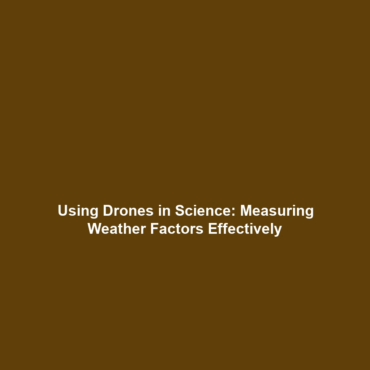How Drones are Deployed to Measure Temperature, Humidity, Wind Patterns, and Pressure
Introduction
Drones, or unmanned aerial vehicles (UAVs), have transformed scientific research by providing innovative solutions for measuring temperature, humidity, wind patterns, and pressure. This technology allows for precise environmental monitoring over areas that are difficult to access, such as forests, oceans, and remote fields. In the broader context of drones in science, these aerial platforms enhance data collection efficiencies, enabling researchers to conduct studies in real-time and gather comprehensive atmospheric data that contributes to climate science, agriculture, and disaster management.
Key Concepts
Understanding Drone Technology
Drones equipped with various sensors can gather meteorological data from different altitudes, offering insights into local climate conditions. The primary concepts include:
- Temperature Measurement: Drones utilize infrared sensors to capture surface temperatures, helping scientists analyze thermal patterns in different landscapes.
- Humidity Detection: Sensors on drones can measure humidity levels at various altitudes, providing critical information for weather forecasting.
- Wind Pattern Analysis: Drones equipped with anemometers can track wind speed and direction, collecting data that improves climate models.
- Pressure Sensing: Barometric sensors on drones measure atmospheric pressure variations, key to understanding weather systems.
Applications and Real-World Uses
The deployment of drones to measure temperature, humidity, wind patterns, and pressure offers numerous applications in drones in science. Key examples include:
- Agriculture: Farmers use drones for precision agriculture, adjusting irrigation based on humidity and temperature readings.
- Disaster Response: Drones assist in monitoring environmental conditions during natural disasters, allowing for timely interventions.
- Climate Research: Scientists study atmospheric changes by deploying drones to collect data in hard-to-reach locations, contributing to global warming research.
Current Challenges
Despite their advancements, there are challenges associated with the use of drones for environmental monitoring:
- Regulatory Issues: Compliance with aviation laws and regulations can limit drone operation zones.
- Data Accuracy: Environmental data may be affected by drone altitude, sensor calibration, or weather conditions during data collection.
- Battery Life: Limited flight time due to battery constraints can hinder extensive data collection missions.
Future Research and Innovations
The future of drones in atmospheric science holds significant promise. Innovations in drone technology include:
- Enhanced Sensors: Development of next-generation sensors that provide greater accuracy and a broader range of environmental data.
- Autonomous Capabilities: Advancements in AI can enable drones to autonomously navigate and collect data, improving efficiency.
- Integration with IoT: Connecting drones to Internet of Things (IoT) devices for real-time data analysis and reporting.
Conclusion
In summary, how drones are deployed to measure temperature, humidity, wind patterns, and pressure significantly contributes to the field of drones in science. These advancements not only enhance our understanding of atmospheric sciences but also pave the way for innovative solutions across various sectors. As technology evolves, further research and development promise to overcome current limitations, leading to more effective environmental monitoring strategies. For more insights into related topics, check out our articles on drone technology advancements and their applications in environmental science.
